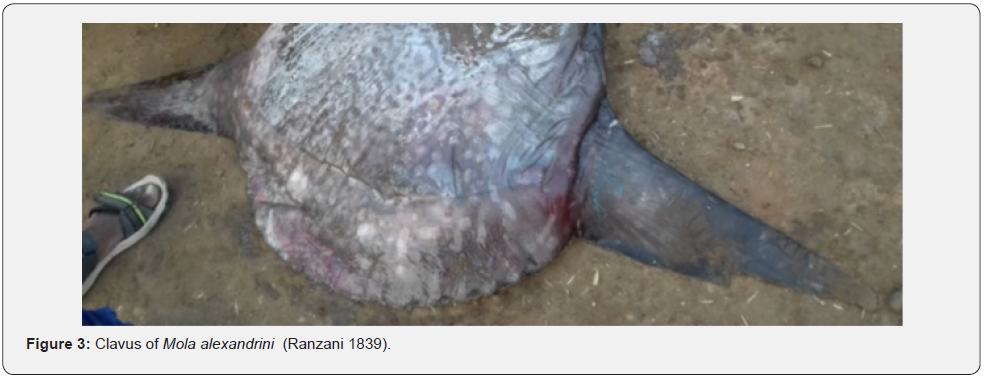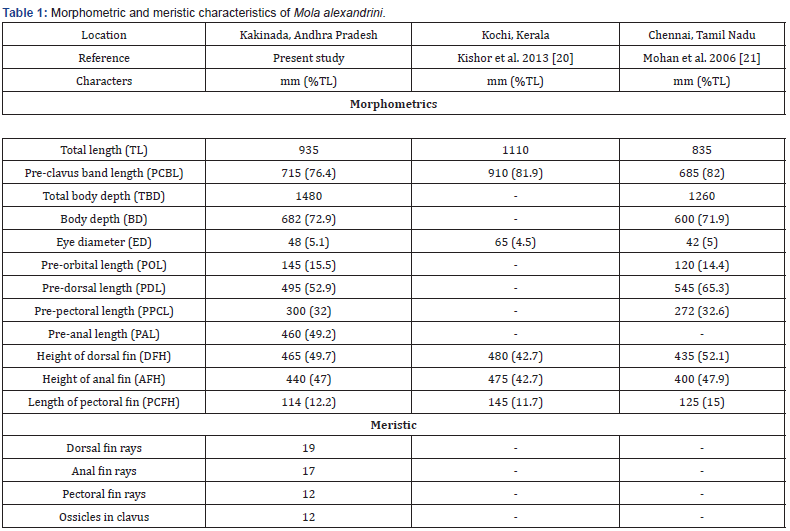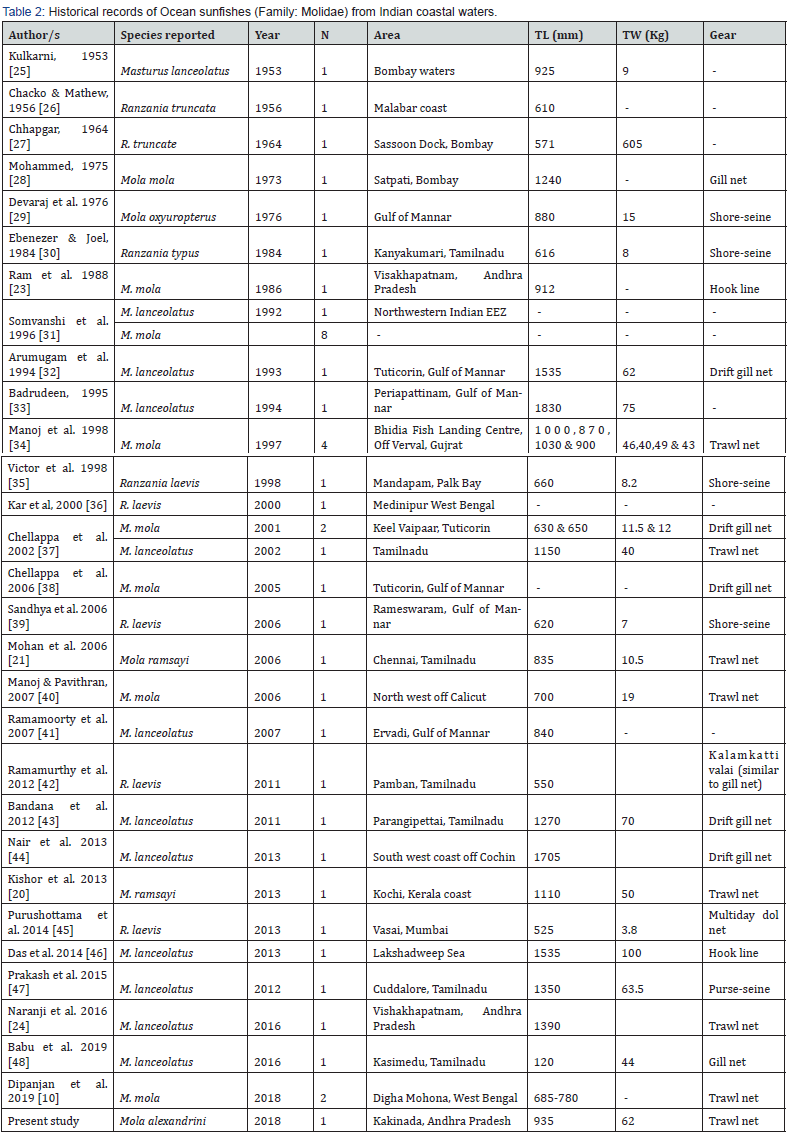First Record of the Ocean Sunfish, Mola alexandrini (Ranzani 1839), (Tetraodontiformes: Molidae) from the Coastal Waters of Andhra Pradesh, India
Oceanography & Fisheries Open Access Journal Juniper Publishers
Abstract
Mola alexandrine, commonly known as bump-head sunfish has been reported for the first time from Andhra Pradesh coastal waters. A detailed morphological description of the specimen is provided, and the morphometric and meristic data are compared with those of the same species reported by earlier workers. Historical records of the family Molidae from Indian waters are summarized and discussed.
Keywords: First record; Mola alexandrine; Morphometrics and meristics; Ocean sunfish
Introduction
The ocean sunfishes belonging to the family Molidae are composed of three genera (Ranzania, Masturus and Mola) with five valid species viz., Ranzania laevis (Pennant 1776), Masturus lanceolatus (Lienard 1840), Mola mola (Linnaeus 1758), Mola tecta (Nyegaard et al. 2017) and Mola alexandrini (Ranzani 1839) [1-4]. Family Molidae is monophyletic among highly derived order Tetraodontiformes [5] and characterized by distinctly-shaped body by the lack of true caudal fin, which is replaced by a broad stiff lobe, a pseudo-caudal fin called clavus [6]. These fishes are known to be active swimmers and opportunistic foragers in the pelagic waters of both temperate and tropical oceans [7-9]. The occurrence of ocean sunfishes is rare from Indian coastal waters [10]. However, the presence of some molds has been reported in new areas [11] and previously known distribution ranges are being expanded [12]. These fishes occupy a unique position in marine food web [13,14]. The consumption of these oddly species has not been attracted the folk’s attention due to their rare occurrence and lack of information on their nutritional aspects. However, the meat of the ocean sunfishes is reported to be delicious in Taiwan and Japan [15].
The bump-head sunfish, Mola alexandrini (Ranzani 1839) is a large pelagic species which claimed a record of world’s heaviest teleost fish with a weight of 2,300 kg with 272 cm TL [16]. However, this fish may grow even larger [17]. Sawai et al. [16] found Mola alexandrini (Ranzani 1839) to be synonymous with Mola ramsayi (Giglioli 1883). The present study reports the first record of M. alexandrini from the coastal waters of Andhra Pradesh, India, and an attempt was made to compare the morphological, morphometric, and meristic characters among the known records of the species. The historical records of the family Molidae from the Indian coastal waters are provided and discussed.
Materials and Methods
One specimen of M. alexandrini was collected as by-catch from trawl catches of Kakinada fishing harbor (16° 58′ 30″ N, 82° 16′ 44″ E), East Godavari district, Andhra Pradesh, India (Figure 1). The fish was caught from commercial trawler operated at a depth range of 20-100m on 11th December 2018. The morphological characters were observed in fresh specimen. Morphometric and meristic details were recorded using the standard methods of Fraser-Brunner [6] and Whitley [18]. The species was identified based on the description given by Fraser-Brunner [6]; Sawai et al. [16]; Yosita et al. [17]; Nyegaard et al. [19]. Morphometric measurements were taken as straight-line distances (±1mm) using a 500 cm tape with 1mm gradation.

They included the total length (TL), a linear distance from the tip of the snout to the distal edge of the clavus; pre-clavus band length (PCBL), the straight distance from the tip of snout to the origin of clavus; total body depth (TBD), a linear length between dorsal fin and anal fin tips; body depth (BD), vertical distance between the dorsal and ventral margin of the body where the height is greatest; eye diameter (ED), the distance between the anterior and posterior edges of the orbit; pre-orbital length (POL), the distance between the tip of snout to the origin of eye orbit; pre-dorsal length (PDL), a straight distance from the tip of the snout to the anterior edge of dorsal fin; pre-pectoral length (PPCL), measured from the tip of snout to the anterior end of the pectoral fin; pre-anal length (PAL), a straight distance from the tip of the snout to the anterior end of the anal fin; height of dorsal fin (DFH), the vertical distance from the base to the tip of the dorsal fin; height of anal fin (AFH), the vertical distance from the base to the tip of the anal fin; and length of pectoral fin (PCFL), measured between its origin to the extreme tip. Meristic characteristics included the counts of fin rays in dorsal, pectoral, and anal fins, and clavus ossicles.
Results
Taxonomic position
• Phylum: Chordata
• Class: Actinopterygii
• Order: Tetraodontiformes Berg, 1940
• Family: Molidae Bonaparte, 1835
• Genus: Mola Koelreuter, 1766
• Species: M. alexandrini (Ranzani 1839).
Description
Body orbicular, deep and laterally compressed; skin thick and leathery; scales rectangular; mouth small and terminal; teeth on both jaws fused and beak-like; eyes small; pair of small nostrils in front of eyes; head bump extends from above the eyes to the base of dorsal fin; chin bump from beneath the lower jaw to anal fin base; gill openings small and oval; dorsal and anal fins opposite and triangle shaped; fins with soft rays and spineless; pelvic and caudal fins absent; caudal fin replaced by broad clavus with round margin; smooth band at the base of clavus between dorsal and anal fins; pectoral fin small rounded. Body gray to silvery white dorsally, dusky white ventrally, dorsal and clavus region with reddish brown tinge; fins bluish black, and many irregular paler spots over the body (Figures 2 & 3). The morphometric and meristic characters of the present specimen along with those of earlier works on M. alexandrini are shown in Table 1.
Discussion
The homogeneity in the morphological characters of Mola has created confusion in the species identification. However, the major distinguishing characters for the identification of Mola species are the presence or absence of head bump, chin bump and smooth band back-fold at the base of clavus; shape of the clavus margin; number of fin rays and ossicles in clavus; and the shape of the body scales [6,16,17,19-22]. The diagnostic characters of M. alexandrini observed in the present study such as the presence of head and chin bumps; smooth band at the base of clavus without a back-fold; rounded clavus; 12 clavus ossicles; scales rectangular on middle region of body and paler spots over the body are in conformity with those observed by the earlier workers [6,16,19].


The historical records of the family Molidae for over 65 years (1953-2018) from Indian coastal waters have been presented in Table 2. Based on the historical data, the distribution of the family Molidae in Indian waters is restricted to four species namely M. mola, M. lanceolatus, R. laveis, and M. alexandrini. Of these, M. mola [23] and M. lanceolatus [24] have been reported from coastal waters of Andhra Pradesh. M. alexandrini was reported in Indian waters with the rare occurrence of two records, one from Chennai, Tamil Nadu by Mohan et al. [21] and the other from Kochi, Kerala by Kishor et al. [20]. Hence, it is evident that the current reporting of M. alexandrini is the 3rd record from India and the first ever report from Andhra Pradesh.
In Indian coastal waters, the ocean sunfishes are considered as vagrant species, with only few sporadic sightings. Since 1990’s, however, there has been a considerable increase in the frequency of molids observed in Indian waters [25-30] (Table 2). The occurrence of M. alexandrini in the study area might be due to the fact that the species which are weak may get drifted to the coastal waters by strong currents or in course of chasing specific plankton/diatoms, as they are opportunistic foragers and selective feeders [3,5,13]. Moreover, in recent times there has been a massive development of fisheries and upgraded fishing vessels extended their trawling operations into deeper waters, catching more varieties of fishes in the study region [31-35]. The present report of the species from Andhra Pradesh coastal waters along central east coast of India would help in creating new awareness and scope for the proper documentation of data on this deficient species from the Indian waters [36-47].


N- Number of individuals; TL- Total length; TW- Total weight
To Know More About Oceanography & Fisheries Open Access Journal Please click on:
https://juniperpublishers.com/ofoaj/index.php
For more Open Access Journals in Juniper Publishers please click on:
https://juniperpublishers.com/index.php

Comments
Post a Comment